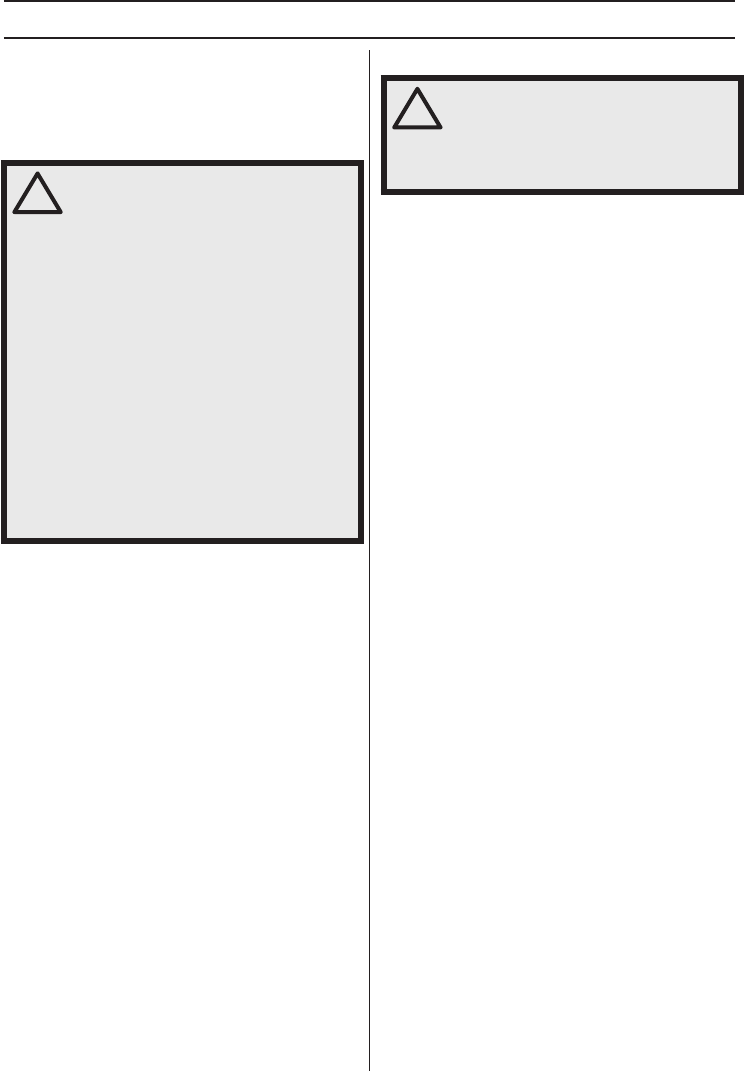
AMERICAN STANDARD SAFETY PRECAUTIONS
English – 43
1153137-95 Rev.2 2009-12-29
Safety precautions for chain saw
users
(ANSI B175.1-2000 Annex C)
Kickback safety precautions
With a basic understanding of kickback, you can reduce
or eliminate the element of surprise. Sudden surprise
contributes to accidents.
Keep a good firm grip on the saw with both hands, the
r
ight hand on the rear handle, and the left hand on the
front handle, when the engine is running. Use a firm grip
with thumbs and fingers encircling the chain saw handles.
A firm grip will help you reduce kickback and maintain
control of the saw. Don’t let go.
Make sure that the area in which you are cutting is free
from obstacles
. Do not let the nose of the guide bar
contact a log, branch, or any other obstacle which could
be hit while you are operating the saw.
Cut at high engine speeds.
Do not overreach or cut above shoulder height.
Follow manufacturer’s sharpening and maintenance
instructions for the saw chain.
Only use replacement bars and chains specified by the
manufacturer or the equivalent.
Other safety precautions
Do not operate a chain saw when you are fatigued.
Use safety footwear; snug-fitting clothing, protective
glo
ves, and eye, hearing and head protection devices.
Use caution when handling fuel. Move the chain saw at
least 10 f
eet (3 m) from the fueling point before starting
the engine.
Do not allow other persons to be near the chain saw when
star
ting or cutting with the chain saw. Keep bystanders
and animals out of the work area.
Do not start cutting until you have a clear work area,
secure f
ooting and a planned retreat path from the falling
tree.
Keep all parts of your body away from the saw chain when
the engine is r
unning.
Before you start the engine, make sure that the saw chain
is not contacting an
ything.
Carry the chain saw with the engine stopped, the guide
bar and sa
w chain to the rear, and the muffler away from
your body.
Do not operate a chain saw that is damaged, improperly
adjusted, or not completely and securely assemb
led. Be
sure that the saw chain stops moving when the throttle
control trigger is released.
Shut off the engine before setting the chain saw down.
Use extreme caution when cutting small size brush and
saplings because slender material may catch the saw
chain and be whipped toward you or pull you off balance.
When cutting a limb that is under tension be alert for
spr
ingback so that you will not be struck when the tension
in the wood fibers is released.
Keep handles dry, clean and free of oil or fuel mixture.
Operate the chain saw only in well-ventilated areas.
Do not operate a chain saw in a tree unless you have
been specifically tr
ained to do so.
Do not operate a chain saw above shoulder height.
All chain saw service, other than the items listed in the
oper
ator’s/owner’s safety and maintenance instructions,
should be performed by competent chain saw service
personnel. (For example, if improper tools are used to
remove the flywheel or if an improper tool is used to hold
the flywheel in order to remove the clutch, structural
damage to the flywheel could occur and subsequently
cause the flywheel to burst.)
When transporting your chain saw, use the appropriate
guide bar guard.
Note: This Annex is intended primarily for the consumer or
occasional user.
!
WARNING! Kickback may occur when
the nose or tip of the guide bar touches
an object, or when the wood closes in
and pinches the saw chain in the cut.
Tip contact in some cases may cause a
lightning fast reverse reaction, kicking
the guide bar up and back towards the
operator.
Pinching the saw chain along the top of
the guide bar may push the guide bar
rapidly back towards the operator.
Either of these reactions may cause you
to lose control of the saw which could
result in serious personal injury.
Do not rely exclusively upon the safety
devices built into your saw. As a chain
saw user, you should take several steps
to keep your cutting jobs free from
accident or injury.
!
WARNING! Do not operate a chain saw
with one hand! Serious injury to the
operator, helpers, bystanders or any
combination of these persons may result
from one-handed operation. A chain saw
is intended for two-handed use.


















